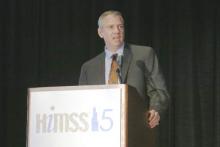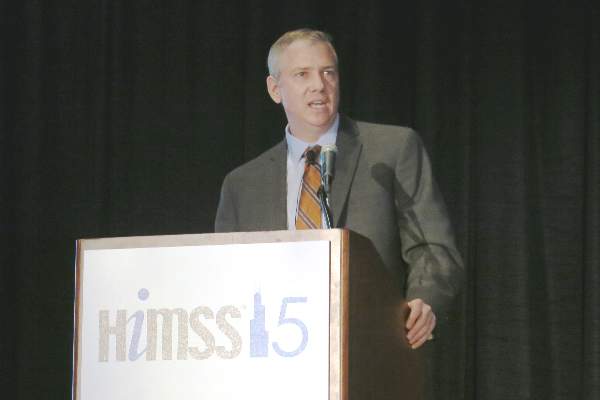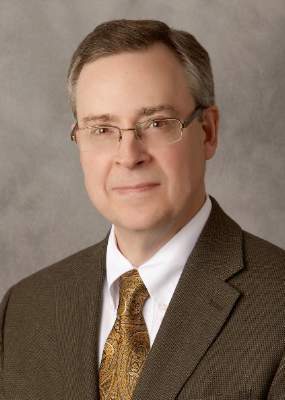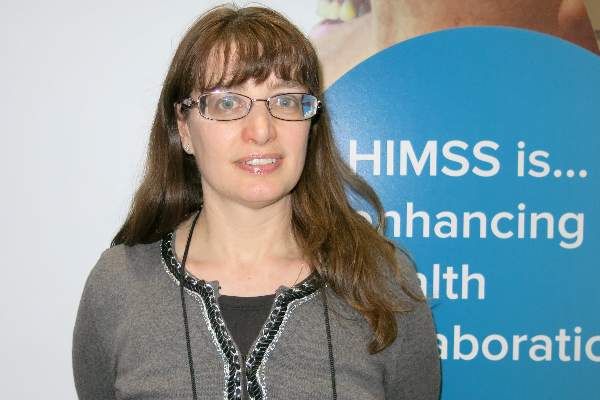User login
Cyber thieves exploiting health care security gaps
CHICAGO – Health care data theft represents a far greater threat than theft of credit card, financial, and banking information.
The reasons are simple: stolen health care records have a longer shelf life and offer a higher payout on the black market, James Trainor, deputy assistant director of the Federal Bureau of Investigation’s Cyber Division, said at the annual meeting of the Healthcare Information Management Systems Society.
When credit cards are stolen it’s pretty easy to identify the information on cyber crime forums and compensate for loss, so the value of that stolen credit card or bank record has a certain shelf life. For health care records, it’s harder to identify where those stolen records may end up and as such it creates a greater challenge for law enforcement.
The opportunity to exploit and monetize stolen health care data for various forms of fraud such as identity, Medicaid, tax, medical device, and pharmaceutical fraud increases the value at which they can be sold online.
“Actually, it’s one of the primary reasons why criminal organizations go after health care records,” Mr. Trainor said.
Not surprisingly, the FBI rates health care data theft as a Tier 1 priority, capable of causing “catastrophic or severe harm.”
And the problem is growing. Two years ago, a significant cyber intrusion occurred every 2 weeks; now it happens every 2-3 days.
“The pace is growing rapidly, the volume of data that’s being [stolen] is substantially increasing, and it just requires a much more robust response across the U.S. government and private sector,” said Mr. Trainor, who helped investigate the December 2014 Sony cyber attack.
Some of the unique challenges to the health care sector are the use of legacy computer systems, “bring your own device” policies, and increased volume of data following the transition to electronic health records, and stolen protected health information isn’t readily discovered, he said. The range, size, and capability of IT infrastructure varies dramatically as do the funding and resources needed to keep up with the rapidly changing IT field.
Other challenges include video conferencing systems, digital video systems used for consultations and remote procedures, and Internet-connected medical devices such as insulin pumps, pacemakers, and MRI machines, said Kevin Hemsley, a project manager at the Idaho National Laboratory supporting the Department of Homeland Security’s Industrial Control Systems Computer Emergency Response Team.
While providers love the ability to use the Internet to control and monitor devices, ingrained security mechanisms can be minimal. This makes for low-hanging fruit for thieves who can enter the system and even lock up an otherwise safe device.
Mr. Hemsley noted that a 2014 report by the Internet security and training firm SANS found that 33% of malicious traffic passed through or was transmitted from VPN applications and devices versus 16% from firewalls, 7% from routers, and 3% from enterprise network controllers.
“One of the messages here is to look at cyber security as being more than HIPPA, it’s patient safety,” he said.
Both experts advised physicians and other health care providers to update their privacy and security software frequently. Available resources include the FBI’s 24-hour CyWatch (855-292-3937/[email protected]), Cyber Task Force (with 56 local field offices), and for individuals, the Internet Crime Complaint Center (www.ic3.gov).
Speedy communication with officials following a data breech is important not just to get the institution’s system back up and running, but it allows officials to identify data footprints left by hackers before they are destroyed, Mr. Trainor said.
In two of the three recent high profile health care cyber attacks involving Community Health Systems (4.5 million accounts), Anthem Blue Cross Blue Shield (78 million records), and Premera Blue Cross (11 million consumers), the institutions contacted the FBI, but in one unnamed case, the FBI had to make the call, he pointed out.
CHICAGO – Health care data theft represents a far greater threat than theft of credit card, financial, and banking information.
The reasons are simple: stolen health care records have a longer shelf life and offer a higher payout on the black market, James Trainor, deputy assistant director of the Federal Bureau of Investigation’s Cyber Division, said at the annual meeting of the Healthcare Information Management Systems Society.
When credit cards are stolen it’s pretty easy to identify the information on cyber crime forums and compensate for loss, so the value of that stolen credit card or bank record has a certain shelf life. For health care records, it’s harder to identify where those stolen records may end up and as such it creates a greater challenge for law enforcement.
The opportunity to exploit and monetize stolen health care data for various forms of fraud such as identity, Medicaid, tax, medical device, and pharmaceutical fraud increases the value at which they can be sold online.
“Actually, it’s one of the primary reasons why criminal organizations go after health care records,” Mr. Trainor said.
Not surprisingly, the FBI rates health care data theft as a Tier 1 priority, capable of causing “catastrophic or severe harm.”
And the problem is growing. Two years ago, a significant cyber intrusion occurred every 2 weeks; now it happens every 2-3 days.
“The pace is growing rapidly, the volume of data that’s being [stolen] is substantially increasing, and it just requires a much more robust response across the U.S. government and private sector,” said Mr. Trainor, who helped investigate the December 2014 Sony cyber attack.
Some of the unique challenges to the health care sector are the use of legacy computer systems, “bring your own device” policies, and increased volume of data following the transition to electronic health records, and stolen protected health information isn’t readily discovered, he said. The range, size, and capability of IT infrastructure varies dramatically as do the funding and resources needed to keep up with the rapidly changing IT field.
Other challenges include video conferencing systems, digital video systems used for consultations and remote procedures, and Internet-connected medical devices such as insulin pumps, pacemakers, and MRI machines, said Kevin Hemsley, a project manager at the Idaho National Laboratory supporting the Department of Homeland Security’s Industrial Control Systems Computer Emergency Response Team.
While providers love the ability to use the Internet to control and monitor devices, ingrained security mechanisms can be minimal. This makes for low-hanging fruit for thieves who can enter the system and even lock up an otherwise safe device.
Mr. Hemsley noted that a 2014 report by the Internet security and training firm SANS found that 33% of malicious traffic passed through or was transmitted from VPN applications and devices versus 16% from firewalls, 7% from routers, and 3% from enterprise network controllers.
“One of the messages here is to look at cyber security as being more than HIPPA, it’s patient safety,” he said.
Both experts advised physicians and other health care providers to update their privacy and security software frequently. Available resources include the FBI’s 24-hour CyWatch (855-292-3937/[email protected]), Cyber Task Force (with 56 local field offices), and for individuals, the Internet Crime Complaint Center (www.ic3.gov).
Speedy communication with officials following a data breech is important not just to get the institution’s system back up and running, but it allows officials to identify data footprints left by hackers before they are destroyed, Mr. Trainor said.
In two of the three recent high profile health care cyber attacks involving Community Health Systems (4.5 million accounts), Anthem Blue Cross Blue Shield (78 million records), and Premera Blue Cross (11 million consumers), the institutions contacted the FBI, but in one unnamed case, the FBI had to make the call, he pointed out.
CHICAGO – Health care data theft represents a far greater threat than theft of credit card, financial, and banking information.
The reasons are simple: stolen health care records have a longer shelf life and offer a higher payout on the black market, James Trainor, deputy assistant director of the Federal Bureau of Investigation’s Cyber Division, said at the annual meeting of the Healthcare Information Management Systems Society.
When credit cards are stolen it’s pretty easy to identify the information on cyber crime forums and compensate for loss, so the value of that stolen credit card or bank record has a certain shelf life. For health care records, it’s harder to identify where those stolen records may end up and as such it creates a greater challenge for law enforcement.
The opportunity to exploit and monetize stolen health care data for various forms of fraud such as identity, Medicaid, tax, medical device, and pharmaceutical fraud increases the value at which they can be sold online.
“Actually, it’s one of the primary reasons why criminal organizations go after health care records,” Mr. Trainor said.
Not surprisingly, the FBI rates health care data theft as a Tier 1 priority, capable of causing “catastrophic or severe harm.”
And the problem is growing. Two years ago, a significant cyber intrusion occurred every 2 weeks; now it happens every 2-3 days.
“The pace is growing rapidly, the volume of data that’s being [stolen] is substantially increasing, and it just requires a much more robust response across the U.S. government and private sector,” said Mr. Trainor, who helped investigate the December 2014 Sony cyber attack.
Some of the unique challenges to the health care sector are the use of legacy computer systems, “bring your own device” policies, and increased volume of data following the transition to electronic health records, and stolen protected health information isn’t readily discovered, he said. The range, size, and capability of IT infrastructure varies dramatically as do the funding and resources needed to keep up with the rapidly changing IT field.
Other challenges include video conferencing systems, digital video systems used for consultations and remote procedures, and Internet-connected medical devices such as insulin pumps, pacemakers, and MRI machines, said Kevin Hemsley, a project manager at the Idaho National Laboratory supporting the Department of Homeland Security’s Industrial Control Systems Computer Emergency Response Team.
While providers love the ability to use the Internet to control and monitor devices, ingrained security mechanisms can be minimal. This makes for low-hanging fruit for thieves who can enter the system and even lock up an otherwise safe device.
Mr. Hemsley noted that a 2014 report by the Internet security and training firm SANS found that 33% of malicious traffic passed through or was transmitted from VPN applications and devices versus 16% from firewalls, 7% from routers, and 3% from enterprise network controllers.
“One of the messages here is to look at cyber security as being more than HIPPA, it’s patient safety,” he said.
Both experts advised physicians and other health care providers to update their privacy and security software frequently. Available resources include the FBI’s 24-hour CyWatch (855-292-3937/[email protected]), Cyber Task Force (with 56 local field offices), and for individuals, the Internet Crime Complaint Center (www.ic3.gov).
Speedy communication with officials following a data breech is important not just to get the institution’s system back up and running, but it allows officials to identify data footprints left by hackers before they are destroyed, Mr. Trainor said.
In two of the three recent high profile health care cyber attacks involving Community Health Systems (4.5 million accounts), Anthem Blue Cross Blue Shield (78 million records), and Premera Blue Cross (11 million consumers), the institutions contacted the FBI, but in one unnamed case, the FBI had to make the call, he pointed out.
EXPERT ANALYSIS FROM HIMSS15
Diagnostic errors top malpractice claims against emergency physicians
More than half of medical malpractice lawsuits against emergency physicians involve allegations of diagnostic errors, according to a study by national medical liability insurer The Doctors Company published online April 13.
Darrell Ranum, vice president for patient safety and risk management for The Doctors Company, and his colleagues, analyzed 332 emergency medicine claims in the insurer’s database that were closed from 2007 to 2013. Most claims (57%) were diagnostic related; they included allegations of failure to establish a differential diagnosis, failure to order diagnostic tests, failure to address abnormal findings, and failure to consider available clinical information.
A key lesson from the study is the importance of a thorough differential diagnosis by emergency physicians, Dr. David B. Troxel, medical director for The Doctors Company said in an interview.
“Our hope is that as physicians review the findings of this study, they will scrutinize their own systems and processes and determine whether the weaknesses identified in the study exist in their organization,” Dr. Troxel said.
Among the other claims, 13% related to improper management or treatment, 5% claimed improper performance of treatment, and 3% alleged failure to order medication.
The study also analyzed top factors that contributed to patient injury in the ED. Problems with patient assessments, such as failure to address abnormal findings, were the most common contributor at 52%. Patient factors, such as physical characteristics and noncompliance, were the second-most-frequent contributor at 21%. Other factors were lack of communication among physicians (17%), poor communication between doctors and patients (14%), insufficient or lack of documentation (13%), and workflow/workload issues (12%). (Claims could have more than one contributing factor.)
The study shows how important strong communication is in the emergency department (ED), said Mr. Ranum. He pointed out one claim in which a patient’s vital signs had changed during the course of a visit. The changes were not communicated to the emergency physician, and he inappropriately discharged the patient. In another case, a patient’s history of overdoses was not conveyed during a patient hand-off, which resulted in an overdose that was not treated in a timely manner, he said.
Communication breakdowns between physicians and patients also can be catalysts for legal claims.
“Sometimes, we find that patients don’t always understand instructions,” Mr. Ranum said. “If patients don’t understand the communication from their providers or if patient receives inadequate information, such as in situations where you have a language barrier, you can have problems there as well.”
Other injury contributors, such as workflow problems, are difficult for emergency physicians to control alone, said Dr. Roneet Lev, director of ED operations for Scripps Mercy Hospital in San Diego.
“We are all struggling with the right balance of staffing and really dependent also on hospital staffing,” Dr. Lev said in an interview. “We’re able to control on the physician end, how many doctors are there, but we’re not in control of how many nurses are there, how many techs are there, how many secretaries are there. That’s a huge part of the workflow. [Physicians are] only a small piece of the bottleneck.”
The study provides helpful information that emergency physicians can use to assess their own systems, Mr. Ranum said.
“Sometimes physicians feel like we’re beating up on them because we parade this whole line of cases where in many [instances], a physician’s care was not adequate,” he said. “We recognize that the systems that are used in hospital emergency departments are complex systems. When those systems fail, there’s an increased chance that a patient will be harmed a result. When physicians read the study, we would ask that they look at their own situation and organization and say, ‘Could these problem occur here?’ And if so, we would encourage them to undertake review of their own processes.”
On Twitter @legal_med
More than half of medical malpractice lawsuits against emergency physicians involve allegations of diagnostic errors, according to a study by national medical liability insurer The Doctors Company published online April 13.
Darrell Ranum, vice president for patient safety and risk management for The Doctors Company, and his colleagues, analyzed 332 emergency medicine claims in the insurer’s database that were closed from 2007 to 2013. Most claims (57%) were diagnostic related; they included allegations of failure to establish a differential diagnosis, failure to order diagnostic tests, failure to address abnormal findings, and failure to consider available clinical information.
A key lesson from the study is the importance of a thorough differential diagnosis by emergency physicians, Dr. David B. Troxel, medical director for The Doctors Company said in an interview.
“Our hope is that as physicians review the findings of this study, they will scrutinize their own systems and processes and determine whether the weaknesses identified in the study exist in their organization,” Dr. Troxel said.
Among the other claims, 13% related to improper management or treatment, 5% claimed improper performance of treatment, and 3% alleged failure to order medication.
The study also analyzed top factors that contributed to patient injury in the ED. Problems with patient assessments, such as failure to address abnormal findings, were the most common contributor at 52%. Patient factors, such as physical characteristics and noncompliance, were the second-most-frequent contributor at 21%. Other factors were lack of communication among physicians (17%), poor communication between doctors and patients (14%), insufficient or lack of documentation (13%), and workflow/workload issues (12%). (Claims could have more than one contributing factor.)
The study shows how important strong communication is in the emergency department (ED), said Mr. Ranum. He pointed out one claim in which a patient’s vital signs had changed during the course of a visit. The changes were not communicated to the emergency physician, and he inappropriately discharged the patient. In another case, a patient’s history of overdoses was not conveyed during a patient hand-off, which resulted in an overdose that was not treated in a timely manner, he said.
Communication breakdowns between physicians and patients also can be catalysts for legal claims.
“Sometimes, we find that patients don’t always understand instructions,” Mr. Ranum said. “If patients don’t understand the communication from their providers or if patient receives inadequate information, such as in situations where you have a language barrier, you can have problems there as well.”
Other injury contributors, such as workflow problems, are difficult for emergency physicians to control alone, said Dr. Roneet Lev, director of ED operations for Scripps Mercy Hospital in San Diego.
“We are all struggling with the right balance of staffing and really dependent also on hospital staffing,” Dr. Lev said in an interview. “We’re able to control on the physician end, how many doctors are there, but we’re not in control of how many nurses are there, how many techs are there, how many secretaries are there. That’s a huge part of the workflow. [Physicians are] only a small piece of the bottleneck.”
The study provides helpful information that emergency physicians can use to assess their own systems, Mr. Ranum said.
“Sometimes physicians feel like we’re beating up on them because we parade this whole line of cases where in many [instances], a physician’s care was not adequate,” he said. “We recognize that the systems that are used in hospital emergency departments are complex systems. When those systems fail, there’s an increased chance that a patient will be harmed a result. When physicians read the study, we would ask that they look at their own situation and organization and say, ‘Could these problem occur here?’ And if so, we would encourage them to undertake review of their own processes.”
On Twitter @legal_med
More than half of medical malpractice lawsuits against emergency physicians involve allegations of diagnostic errors, according to a study by national medical liability insurer The Doctors Company published online April 13.
Darrell Ranum, vice president for patient safety and risk management for The Doctors Company, and his colleagues, analyzed 332 emergency medicine claims in the insurer’s database that were closed from 2007 to 2013. Most claims (57%) were diagnostic related; they included allegations of failure to establish a differential diagnosis, failure to order diagnostic tests, failure to address abnormal findings, and failure to consider available clinical information.
A key lesson from the study is the importance of a thorough differential diagnosis by emergency physicians, Dr. David B. Troxel, medical director for The Doctors Company said in an interview.
“Our hope is that as physicians review the findings of this study, they will scrutinize their own systems and processes and determine whether the weaknesses identified in the study exist in their organization,” Dr. Troxel said.
Among the other claims, 13% related to improper management or treatment, 5% claimed improper performance of treatment, and 3% alleged failure to order medication.
The study also analyzed top factors that contributed to patient injury in the ED. Problems with patient assessments, such as failure to address abnormal findings, were the most common contributor at 52%. Patient factors, such as physical characteristics and noncompliance, were the second-most-frequent contributor at 21%. Other factors were lack of communication among physicians (17%), poor communication between doctors and patients (14%), insufficient or lack of documentation (13%), and workflow/workload issues (12%). (Claims could have more than one contributing factor.)
The study shows how important strong communication is in the emergency department (ED), said Mr. Ranum. He pointed out one claim in which a patient’s vital signs had changed during the course of a visit. The changes were not communicated to the emergency physician, and he inappropriately discharged the patient. In another case, a patient’s history of overdoses was not conveyed during a patient hand-off, which resulted in an overdose that was not treated in a timely manner, he said.
Communication breakdowns between physicians and patients also can be catalysts for legal claims.
“Sometimes, we find that patients don’t always understand instructions,” Mr. Ranum said. “If patients don’t understand the communication from their providers or if patient receives inadequate information, such as in situations where you have a language barrier, you can have problems there as well.”
Other injury contributors, such as workflow problems, are difficult for emergency physicians to control alone, said Dr. Roneet Lev, director of ED operations for Scripps Mercy Hospital in San Diego.
“We are all struggling with the right balance of staffing and really dependent also on hospital staffing,” Dr. Lev said in an interview. “We’re able to control on the physician end, how many doctors are there, but we’re not in control of how many nurses are there, how many techs are there, how many secretaries are there. That’s a huge part of the workflow. [Physicians are] only a small piece of the bottleneck.”
The study provides helpful information that emergency physicians can use to assess their own systems, Mr. Ranum said.
“Sometimes physicians feel like we’re beating up on them because we parade this whole line of cases where in many [instances], a physician’s care was not adequate,” he said. “We recognize that the systems that are used in hospital emergency departments are complex systems. When those systems fail, there’s an increased chance that a patient will be harmed a result. When physicians read the study, we would ask that they look at their own situation and organization and say, ‘Could these problem occur here?’ And if so, we would encourage them to undertake review of their own processes.”
On Twitter @legal_med
CMS: A few claims were processed at 21% SGR cut level
A small volume of Medicare claims were processed at the 21% pay cut level mandated by the Sustainable Growth Rate formula, according to a provider advisory issued April 15 by the Centers for Medicare & Medicaid Services.
Claims were processed April 15 by Medicare Administrative Contractors as the CMS guidance to hold for 10 business days claims submitted beginning April 1 expired.
The claims will be reprocessed automatically at the higher rate, CMS officials said.
The House and Senate have both passed H.R. 2, the Medicare Access and CHIP Reauthorization Act of 2015, which permanently repeals the SGR, among many other provisions. President Obama has indicated he will sign the legislation.
On Twitter @denisefulton
A small volume of Medicare claims were processed at the 21% pay cut level mandated by the Sustainable Growth Rate formula, according to a provider advisory issued April 15 by the Centers for Medicare & Medicaid Services.
Claims were processed April 15 by Medicare Administrative Contractors as the CMS guidance to hold for 10 business days claims submitted beginning April 1 expired.
The claims will be reprocessed automatically at the higher rate, CMS officials said.
The House and Senate have both passed H.R. 2, the Medicare Access and CHIP Reauthorization Act of 2015, which permanently repeals the SGR, among many other provisions. President Obama has indicated he will sign the legislation.
On Twitter @denisefulton
A small volume of Medicare claims were processed at the 21% pay cut level mandated by the Sustainable Growth Rate formula, according to a provider advisory issued April 15 by the Centers for Medicare & Medicaid Services.
Claims were processed April 15 by Medicare Administrative Contractors as the CMS guidance to hold for 10 business days claims submitted beginning April 1 expired.
The claims will be reprocessed automatically at the higher rate, CMS officials said.
The House and Senate have both passed H.R. 2, the Medicare Access and CHIP Reauthorization Act of 2015, which permanently repeals the SGR, among many other provisions. President Obama has indicated he will sign the legislation.
On Twitter @denisefulton
Mobile health survey: Half of providers see patient benefit
CHICAGO – A majority of health providers use some form of mobile technology to engage patients, but only half have experienced improved care coordination or cost savings from doing so.
The new data comes from a study presented April 14 at the annual meeting of the Healthcare Information and Management Systems Society. The survey of 238 health providers found 90% of respondents use at least one type of mobile device to engage patients. Fifty-one percent indicated the technology affected their ability to greatly impact or coordinate patient care, while another 41% reported they had not experienced a strong impact on care coordination.
Similarly, 54% of respondents reported they achieved cost savings based on mobile technology use, while 42% were unsure about the effect on cost savings, and 3% said the technology had not yielded cost savings.
The most common mobile technology used was app-enabled patient portals (73%). At least half of respondents reported using telehealth services (62%) or text messaging (57%) with patients.
About one-third indicated a high degree of effectiveness in engaging patients using app-enabled patient portals, while 27% reported the same using telehealth services, such as video consults. Apps, such as prescribing apps, were least likely to engage patients.
Telehealth services and app-enabled patient portals also were the top technologies for future investment, said Jennifer Horowitz, HIMSS senior director for research.
Physicians and other health providers “are starting to see some really good traction with these types of technologies so they’re planning on moving forward with them in the future,” she said. “Organizations are starting out on their journey, and they need to continue on that journey to make sure these are effective technologies for their patients.”
Only 8% of respondents reported that all data captured by mobile devices was integrated into their electronic health record system (EHR). Another 6% said at least three-quarters of data was integrated; a third (32%) said no mobile data was integrated into their EHR.
“That leaves a really wide road to opportunity for health care organizations to make sure they’re creating a strategy to integrate that data into their environment,” Ms. Horowitz said.
Respondents noted that telehealth interventions had the greatest impact on care coordination, particularly in radiology and neurology.
When it comes to saving money, respondents reported the primary cost savers were mobile-enhanced preventive care, wellness management, and disease surveillance.
For physicians, the survey results highlight the importance of utilizing mobile technology as they adapt to changing health care rules and new models of care delivery, David A. Collins, HIMSS senior director of health information systems said in an interview.
“To align themselves with the demands of the health care system – the value-based system, the [accountable care organization concept] – technology is a tool to be leveraged to achieve those cost savings,” Mr. Collins said in an interview. “Its a lot cheaper to issue $800 worth of equipment to a patient than it is to have them readmitted and lose thousands of dollars” in subsequent care.
The 2015 HIMSS Mobile Technology Study analyzed responses from health care executives, physicians, health providers, and IT specialists between Jan. 15, 2015, and Feb. 13, 2015. The respondents worked for hospitals, medical practices, health systems, and other health care entities, such as academic medical centers and emergency services providers.
On Twitter @legal_med
CHICAGO – A majority of health providers use some form of mobile technology to engage patients, but only half have experienced improved care coordination or cost savings from doing so.
The new data comes from a study presented April 14 at the annual meeting of the Healthcare Information and Management Systems Society. The survey of 238 health providers found 90% of respondents use at least one type of mobile device to engage patients. Fifty-one percent indicated the technology affected their ability to greatly impact or coordinate patient care, while another 41% reported they had not experienced a strong impact on care coordination.
Similarly, 54% of respondents reported they achieved cost savings based on mobile technology use, while 42% were unsure about the effect on cost savings, and 3% said the technology had not yielded cost savings.
The most common mobile technology used was app-enabled patient portals (73%). At least half of respondents reported using telehealth services (62%) or text messaging (57%) with patients.
About one-third indicated a high degree of effectiveness in engaging patients using app-enabled patient portals, while 27% reported the same using telehealth services, such as video consults. Apps, such as prescribing apps, were least likely to engage patients.
Telehealth services and app-enabled patient portals also were the top technologies for future investment, said Jennifer Horowitz, HIMSS senior director for research.
Physicians and other health providers “are starting to see some really good traction with these types of technologies so they’re planning on moving forward with them in the future,” she said. “Organizations are starting out on their journey, and they need to continue on that journey to make sure these are effective technologies for their patients.”
Only 8% of respondents reported that all data captured by mobile devices was integrated into their electronic health record system (EHR). Another 6% said at least three-quarters of data was integrated; a third (32%) said no mobile data was integrated into their EHR.
“That leaves a really wide road to opportunity for health care organizations to make sure they’re creating a strategy to integrate that data into their environment,” Ms. Horowitz said.
Respondents noted that telehealth interventions had the greatest impact on care coordination, particularly in radiology and neurology.
When it comes to saving money, respondents reported the primary cost savers were mobile-enhanced preventive care, wellness management, and disease surveillance.
For physicians, the survey results highlight the importance of utilizing mobile technology as they adapt to changing health care rules and new models of care delivery, David A. Collins, HIMSS senior director of health information systems said in an interview.
“To align themselves with the demands of the health care system – the value-based system, the [accountable care organization concept] – technology is a tool to be leveraged to achieve those cost savings,” Mr. Collins said in an interview. “Its a lot cheaper to issue $800 worth of equipment to a patient than it is to have them readmitted and lose thousands of dollars” in subsequent care.
The 2015 HIMSS Mobile Technology Study analyzed responses from health care executives, physicians, health providers, and IT specialists between Jan. 15, 2015, and Feb. 13, 2015. The respondents worked for hospitals, medical practices, health systems, and other health care entities, such as academic medical centers and emergency services providers.
On Twitter @legal_med
CHICAGO – A majority of health providers use some form of mobile technology to engage patients, but only half have experienced improved care coordination or cost savings from doing so.
The new data comes from a study presented April 14 at the annual meeting of the Healthcare Information and Management Systems Society. The survey of 238 health providers found 90% of respondents use at least one type of mobile device to engage patients. Fifty-one percent indicated the technology affected their ability to greatly impact or coordinate patient care, while another 41% reported they had not experienced a strong impact on care coordination.
Similarly, 54% of respondents reported they achieved cost savings based on mobile technology use, while 42% were unsure about the effect on cost savings, and 3% said the technology had not yielded cost savings.
The most common mobile technology used was app-enabled patient portals (73%). At least half of respondents reported using telehealth services (62%) or text messaging (57%) with patients.
About one-third indicated a high degree of effectiveness in engaging patients using app-enabled patient portals, while 27% reported the same using telehealth services, such as video consults. Apps, such as prescribing apps, were least likely to engage patients.
Telehealth services and app-enabled patient portals also were the top technologies for future investment, said Jennifer Horowitz, HIMSS senior director for research.
Physicians and other health providers “are starting to see some really good traction with these types of technologies so they’re planning on moving forward with them in the future,” she said. “Organizations are starting out on their journey, and they need to continue on that journey to make sure these are effective technologies for their patients.”
Only 8% of respondents reported that all data captured by mobile devices was integrated into their electronic health record system (EHR). Another 6% said at least three-quarters of data was integrated; a third (32%) said no mobile data was integrated into their EHR.
“That leaves a really wide road to opportunity for health care organizations to make sure they’re creating a strategy to integrate that data into their environment,” Ms. Horowitz said.
Respondents noted that telehealth interventions had the greatest impact on care coordination, particularly in radiology and neurology.
When it comes to saving money, respondents reported the primary cost savers were mobile-enhanced preventive care, wellness management, and disease surveillance.
For physicians, the survey results highlight the importance of utilizing mobile technology as they adapt to changing health care rules and new models of care delivery, David A. Collins, HIMSS senior director of health information systems said in an interview.
“To align themselves with the demands of the health care system – the value-based system, the [accountable care organization concept] – technology is a tool to be leveraged to achieve those cost savings,” Mr. Collins said in an interview. “Its a lot cheaper to issue $800 worth of equipment to a patient than it is to have them readmitted and lose thousands of dollars” in subsequent care.
The 2015 HIMSS Mobile Technology Study analyzed responses from health care executives, physicians, health providers, and IT specialists between Jan. 15, 2015, and Feb. 13, 2015. The respondents worked for hospitals, medical practices, health systems, and other health care entities, such as academic medical centers and emergency services providers.
On Twitter @legal_med
AT HIMSS15
Multi-Site Hospitalist Leaders: HM15 Session Summary
Session: Multi-site Hospitalist Leaders: Unique Challenges/What You Should Know
HM15 Presenter/Moderator: Scott Rissmiller, MD
Summation: This standing-room-only session was the result of a popular HMX e-community, which has become an active discussion board. As hospitals and health systems continue to consolidate across the country, there has been a rapid growth of multi-hospital systems. The role of the “Chief Hospitalist,” whose job is to lead multiple hospitalist groups within these systems, is evolving. These “Chief Hospitalists” are growing in number and they, as well as their followers, face unique challenges.
These points regarding organization structure were discussed, and as you look at your own organizational structure, these questions deserve your attention:
- Purpose of your structure?
- Is your structure centralized or decentralized?
- How does your organizational structure support decision-making?
- How does the structure ensure proper communication?
- How are resources shared across geography?
- What is your administrative support structure?
- How is administrative time allocated for physician leaders?
- How do you ensure engagement from all providers?
- How does your organization structure create alignment with the healthcare system?
The following compensation issues were discussed, and can be used as a discussion outline for most groups:
- How does your compensation (comp) plan align with the goals and values of the system?
- How does your comp plan account for regional variances?
- How does the comp plan encourage teamwork and sharing of resources?
- How does comp plan account for differences in acuity, hospital size, night frequency, etc.?
- Are goals and incentives group based, site based, or individual based?
- How does the comp plan fairly reward “non-RVU” work? (teaching, committee service, etc.)
- Should all site leaders receive the same comp regardless of group size?
- Does the comp plan incorporate “minimum work standards”/social compact?
Key Points/HM Takeaways:
- Panel discussion was valuable and reassured attendees that there are multiple ways to make groups successful. One common variable of successful groups is open lines of communication at all levels.
- Physician on-boarding is critical and should be utilized to set clear expectations.
- HM Goals/expectations must be aligned with those of the hospital and health system.
- When multiple hospitals are part of a larger system, it is desirable for goals to be aligned across the health system.
- Two-way open communication is necessary for success.
- Try to take a walk in your colleague’s/stakeholder’s shoes:
- How does my hospital administrative partner see this issue?
- How does my regional director/system lead see this issue?
- How does my bedside hospitalist physician/provider see this issue?
- How would my patients view this issue?
- Issues facing different types of groups, academic vs. community and for profit vs. not for profit, are somewhat variable.
- The leadership Dyad consisting of a physician and practice management professional in partnership is an effective and well-proven management model.
Many thanks to Drs. T.J. Richardson and Dan Duzan for their input and assistance with this session summary. Dr. Richardson is a Regional Medical Director and Dr. Duzan is a Facility Medical Director, both work for TeamHealth.
Julianna Lindsey is a hospitalist and physician leader based in the Dallas-Fort Worth Metroplex. Her focus is patient safety/quality and physician leadership. She is a member of TeamHospitalist.
Session: Multi-site Hospitalist Leaders: Unique Challenges/What You Should Know
HM15 Presenter/Moderator: Scott Rissmiller, MD
Summation: This standing-room-only session was the result of a popular HMX e-community, which has become an active discussion board. As hospitals and health systems continue to consolidate across the country, there has been a rapid growth of multi-hospital systems. The role of the “Chief Hospitalist,” whose job is to lead multiple hospitalist groups within these systems, is evolving. These “Chief Hospitalists” are growing in number and they, as well as their followers, face unique challenges.
These points regarding organization structure were discussed, and as you look at your own organizational structure, these questions deserve your attention:
- Purpose of your structure?
- Is your structure centralized or decentralized?
- How does your organizational structure support decision-making?
- How does the structure ensure proper communication?
- How are resources shared across geography?
- What is your administrative support structure?
- How is administrative time allocated for physician leaders?
- How do you ensure engagement from all providers?
- How does your organization structure create alignment with the healthcare system?
The following compensation issues were discussed, and can be used as a discussion outline for most groups:
- How does your compensation (comp) plan align with the goals and values of the system?
- How does your comp plan account for regional variances?
- How does the comp plan encourage teamwork and sharing of resources?
- How does comp plan account for differences in acuity, hospital size, night frequency, etc.?
- Are goals and incentives group based, site based, or individual based?
- How does the comp plan fairly reward “non-RVU” work? (teaching, committee service, etc.)
- Should all site leaders receive the same comp regardless of group size?
- Does the comp plan incorporate “minimum work standards”/social compact?
Key Points/HM Takeaways:
- Panel discussion was valuable and reassured attendees that there are multiple ways to make groups successful. One common variable of successful groups is open lines of communication at all levels.
- Physician on-boarding is critical and should be utilized to set clear expectations.
- HM Goals/expectations must be aligned with those of the hospital and health system.
- When multiple hospitals are part of a larger system, it is desirable for goals to be aligned across the health system.
- Two-way open communication is necessary for success.
- Try to take a walk in your colleague’s/stakeholder’s shoes:
- How does my hospital administrative partner see this issue?
- How does my regional director/system lead see this issue?
- How does my bedside hospitalist physician/provider see this issue?
- How would my patients view this issue?
- Issues facing different types of groups, academic vs. community and for profit vs. not for profit, are somewhat variable.
- The leadership Dyad consisting of a physician and practice management professional in partnership is an effective and well-proven management model.
Many thanks to Drs. T.J. Richardson and Dan Duzan for their input and assistance with this session summary. Dr. Richardson is a Regional Medical Director and Dr. Duzan is a Facility Medical Director, both work for TeamHealth.
Julianna Lindsey is a hospitalist and physician leader based in the Dallas-Fort Worth Metroplex. Her focus is patient safety/quality and physician leadership. She is a member of TeamHospitalist.
Session: Multi-site Hospitalist Leaders: Unique Challenges/What You Should Know
HM15 Presenter/Moderator: Scott Rissmiller, MD
Summation: This standing-room-only session was the result of a popular HMX e-community, which has become an active discussion board. As hospitals and health systems continue to consolidate across the country, there has been a rapid growth of multi-hospital systems. The role of the “Chief Hospitalist,” whose job is to lead multiple hospitalist groups within these systems, is evolving. These “Chief Hospitalists” are growing in number and they, as well as their followers, face unique challenges.
These points regarding organization structure were discussed, and as you look at your own organizational structure, these questions deserve your attention:
- Purpose of your structure?
- Is your structure centralized or decentralized?
- How does your organizational structure support decision-making?
- How does the structure ensure proper communication?
- How are resources shared across geography?
- What is your administrative support structure?
- How is administrative time allocated for physician leaders?
- How do you ensure engagement from all providers?
- How does your organization structure create alignment with the healthcare system?
The following compensation issues were discussed, and can be used as a discussion outline for most groups:
- How does your compensation (comp) plan align with the goals and values of the system?
- How does your comp plan account for regional variances?
- How does the comp plan encourage teamwork and sharing of resources?
- How does comp plan account for differences in acuity, hospital size, night frequency, etc.?
- Are goals and incentives group based, site based, or individual based?
- How does the comp plan fairly reward “non-RVU” work? (teaching, committee service, etc.)
- Should all site leaders receive the same comp regardless of group size?
- Does the comp plan incorporate “minimum work standards”/social compact?
Key Points/HM Takeaways:
- Panel discussion was valuable and reassured attendees that there are multiple ways to make groups successful. One common variable of successful groups is open lines of communication at all levels.
- Physician on-boarding is critical and should be utilized to set clear expectations.
- HM Goals/expectations must be aligned with those of the hospital and health system.
- When multiple hospitals are part of a larger system, it is desirable for goals to be aligned across the health system.
- Two-way open communication is necessary for success.
- Try to take a walk in your colleague’s/stakeholder’s shoes:
- How does my hospital administrative partner see this issue?
- How does my regional director/system lead see this issue?
- How does my bedside hospitalist physician/provider see this issue?
- How would my patients view this issue?
- Issues facing different types of groups, academic vs. community and for profit vs. not for profit, are somewhat variable.
- The leadership Dyad consisting of a physician and practice management professional in partnership is an effective and well-proven management model.
Many thanks to Drs. T.J. Richardson and Dan Duzan for their input and assistance with this session summary. Dr. Richardson is a Regional Medical Director and Dr. Duzan is a Facility Medical Director, both work for TeamHealth.
Julianna Lindsey is a hospitalist and physician leader based in the Dallas-Fort Worth Metroplex. Her focus is patient safety/quality and physician leadership. She is a member of TeamHospitalist.
Senate passes SGR repeal
The Senate passed H.R. 2, the Medicare Access and CHIP Reauthorization Act, April 14 by a vote of 92-8.
The bill matches the language that the House passed by an overwhelming majority on March 26 and clears the way for the White House to permanently end the practice of temporary “doc fix” patches necessitated by the Medicare Sustainable Growth Rate formula.
President Obama signed the bill into law April 16.
The bill also extends funding for the Children’s Health Insurance Program for 2 years.
A number of amendments, including attempts to reauthorize CHIP for 4 years and to enforce pay-as-you-go rules that require the bill be fully offset, did not gain the necessary 60 votes for adoption.
The latest cut, a 21% reduction to Medicare physician payments went into effect on April 1, but the Centers for Medicare & Medicaid Services has been holding off on paying claims in anticipation of the bill’s passage. The agency had planned to pay the difference of the claims retroactively if there was a further delay in the passage.
*This article was updated April 17, 2015.
The Senate passed H.R. 2, the Medicare Access and CHIP Reauthorization Act, April 14 by a vote of 92-8.
The bill matches the language that the House passed by an overwhelming majority on March 26 and clears the way for the White House to permanently end the practice of temporary “doc fix” patches necessitated by the Medicare Sustainable Growth Rate formula.
President Obama signed the bill into law April 16.
The bill also extends funding for the Children’s Health Insurance Program for 2 years.
A number of amendments, including attempts to reauthorize CHIP for 4 years and to enforce pay-as-you-go rules that require the bill be fully offset, did not gain the necessary 60 votes for adoption.
The latest cut, a 21% reduction to Medicare physician payments went into effect on April 1, but the Centers for Medicare & Medicaid Services has been holding off on paying claims in anticipation of the bill’s passage. The agency had planned to pay the difference of the claims retroactively if there was a further delay in the passage.
*This article was updated April 17, 2015.
The Senate passed H.R. 2, the Medicare Access and CHIP Reauthorization Act, April 14 by a vote of 92-8.
The bill matches the language that the House passed by an overwhelming majority on March 26 and clears the way for the White House to permanently end the practice of temporary “doc fix” patches necessitated by the Medicare Sustainable Growth Rate formula.
President Obama signed the bill into law April 16.
The bill also extends funding for the Children’s Health Insurance Program for 2 years.
A number of amendments, including attempts to reauthorize CHIP for 4 years and to enforce pay-as-you-go rules that require the bill be fully offset, did not gain the necessary 60 votes for adoption.
The latest cut, a 21% reduction to Medicare physician payments went into effect on April 1, but the Centers for Medicare & Medicaid Services has been holding off on paying claims in anticipation of the bill’s passage. The agency had planned to pay the difference of the claims retroactively if there was a further delay in the passage.
*This article was updated April 17, 2015.
Health data breaches compromised 29 million patient records in 2010-2013
Some 29 million private patient health records were compromised between 2010 and the end of 2013 – mostly as a result of criminal activity, say researchers, who described their findings as a likely underestimate of the magnitude of the problem.
In a research letter published April 14 in JAMA (doi:10.1001/jama.2015.2252), Dr. Vincent Liu of Kaiser Permanente in Oakland, Calif., and his colleagues at Stanford (Calif.) University, evaluated U.S. Department of Health & Human Services reports of data breaches involving 500 or more patient records covered under the Health Insurance Portability and Accountability Act (HIPAA). Of the 949 reported breach events during the 4-year study period, 67% involved electronic media while about 20% were attributed to paper records. Laptop or portable device theft accounted for 33% of all breaches reported.
Importantly, the frequency of breaches from hacking and unauthorized access increased significantly during the study period (from 12% in 2010 to 27% in 2013), and breaches involving external vendors represented 29% of all incidents.
“Given the rapid expansion in electronic health record deployment since 2012, as well as the expected increase in cloud-based services provided by vendors supporting predictive analytics, personal health records, health-related sensors, and gene-sequencing technology, the frequency and scope of electronic health care data breaches are likely to increase,” Dr. Liu and colleagues wrote.
“Our study was limited to breaches that were already recognized, reported, and affecting at least 500 individuals [as required by the HITECH Act of 2009],” Dr. Liu and colleagues wrote. “Therefore, our study likely underestimated the true number of health care data breaches occurring each year.” The study was funded by Permanente Medical Group and the National Institutes of Health. None of its authors reported any relevant conflicts of interest.
Dr. Liu and his colleagues’ research makes clear that the personal health information of patients in the United States is not safe, and it needs to be. Loss of trust in an electronic health information system could seriously undermine efforts to improve health and health care in the United States. The question is what to do.
Part of the responsibility lies with the private custodians of health data, mostly clinicians, health care organizations, and insurers. Although malicious hacking gets the most media attention, the majority of data breaches result from a much more mundane and correctable problem: the failure of covered entities to observe what might be called good data hygiene.
But part of the responsibility also lies with policy makers. Health care organizations and practitioners bemoan HIPAA’s requirements, but in fact the law is antiquated and inadequate to protect patients’ health care privacy and security. The fact that HIPAA regulates only certain entities that hold health data, rather than regulating health data wherever those data reside, seems illogical in today’s digital world.
Dr. David Blumenthal is president of the Commonwealth Fund in New York; Deven McGraw is a health care attorney in Washington. Their comments were made in an editorial accompanying the study (JAMA 2015 [doi:10.1001/jama.2015.2746]). They reported no conflicts of interest related to their comments.
Dr. Liu and his colleagues’ research makes clear that the personal health information of patients in the United States is not safe, and it needs to be. Loss of trust in an electronic health information system could seriously undermine efforts to improve health and health care in the United States. The question is what to do.
Part of the responsibility lies with the private custodians of health data, mostly clinicians, health care organizations, and insurers. Although malicious hacking gets the most media attention, the majority of data breaches result from a much more mundane and correctable problem: the failure of covered entities to observe what might be called good data hygiene.
But part of the responsibility also lies with policy makers. Health care organizations and practitioners bemoan HIPAA’s requirements, but in fact the law is antiquated and inadequate to protect patients’ health care privacy and security. The fact that HIPAA regulates only certain entities that hold health data, rather than regulating health data wherever those data reside, seems illogical in today’s digital world.
Dr. David Blumenthal is president of the Commonwealth Fund in New York; Deven McGraw is a health care attorney in Washington. Their comments were made in an editorial accompanying the study (JAMA 2015 [doi:10.1001/jama.2015.2746]). They reported no conflicts of interest related to their comments.
Dr. Liu and his colleagues’ research makes clear that the personal health information of patients in the United States is not safe, and it needs to be. Loss of trust in an electronic health information system could seriously undermine efforts to improve health and health care in the United States. The question is what to do.
Part of the responsibility lies with the private custodians of health data, mostly clinicians, health care organizations, and insurers. Although malicious hacking gets the most media attention, the majority of data breaches result from a much more mundane and correctable problem: the failure of covered entities to observe what might be called good data hygiene.
But part of the responsibility also lies with policy makers. Health care organizations and practitioners bemoan HIPAA’s requirements, but in fact the law is antiquated and inadequate to protect patients’ health care privacy and security. The fact that HIPAA regulates only certain entities that hold health data, rather than regulating health data wherever those data reside, seems illogical in today’s digital world.
Dr. David Blumenthal is president of the Commonwealth Fund in New York; Deven McGraw is a health care attorney in Washington. Their comments were made in an editorial accompanying the study (JAMA 2015 [doi:10.1001/jama.2015.2746]). They reported no conflicts of interest related to their comments.
Some 29 million private patient health records were compromised between 2010 and the end of 2013 – mostly as a result of criminal activity, say researchers, who described their findings as a likely underestimate of the magnitude of the problem.
In a research letter published April 14 in JAMA (doi:10.1001/jama.2015.2252), Dr. Vincent Liu of Kaiser Permanente in Oakland, Calif., and his colleagues at Stanford (Calif.) University, evaluated U.S. Department of Health & Human Services reports of data breaches involving 500 or more patient records covered under the Health Insurance Portability and Accountability Act (HIPAA). Of the 949 reported breach events during the 4-year study period, 67% involved electronic media while about 20% were attributed to paper records. Laptop or portable device theft accounted for 33% of all breaches reported.
Importantly, the frequency of breaches from hacking and unauthorized access increased significantly during the study period (from 12% in 2010 to 27% in 2013), and breaches involving external vendors represented 29% of all incidents.
“Given the rapid expansion in electronic health record deployment since 2012, as well as the expected increase in cloud-based services provided by vendors supporting predictive analytics, personal health records, health-related sensors, and gene-sequencing technology, the frequency and scope of electronic health care data breaches are likely to increase,” Dr. Liu and colleagues wrote.
“Our study was limited to breaches that were already recognized, reported, and affecting at least 500 individuals [as required by the HITECH Act of 2009],” Dr. Liu and colleagues wrote. “Therefore, our study likely underestimated the true number of health care data breaches occurring each year.” The study was funded by Permanente Medical Group and the National Institutes of Health. None of its authors reported any relevant conflicts of interest.
Some 29 million private patient health records were compromised between 2010 and the end of 2013 – mostly as a result of criminal activity, say researchers, who described their findings as a likely underestimate of the magnitude of the problem.
In a research letter published April 14 in JAMA (doi:10.1001/jama.2015.2252), Dr. Vincent Liu of Kaiser Permanente in Oakland, Calif., and his colleagues at Stanford (Calif.) University, evaluated U.S. Department of Health & Human Services reports of data breaches involving 500 or more patient records covered under the Health Insurance Portability and Accountability Act (HIPAA). Of the 949 reported breach events during the 4-year study period, 67% involved electronic media while about 20% were attributed to paper records. Laptop or portable device theft accounted for 33% of all breaches reported.
Importantly, the frequency of breaches from hacking and unauthorized access increased significantly during the study period (from 12% in 2010 to 27% in 2013), and breaches involving external vendors represented 29% of all incidents.
“Given the rapid expansion in electronic health record deployment since 2012, as well as the expected increase in cloud-based services provided by vendors supporting predictive analytics, personal health records, health-related sensors, and gene-sequencing technology, the frequency and scope of electronic health care data breaches are likely to increase,” Dr. Liu and colleagues wrote.
“Our study was limited to breaches that were already recognized, reported, and affecting at least 500 individuals [as required by the HITECH Act of 2009],” Dr. Liu and colleagues wrote. “Therefore, our study likely underestimated the true number of health care data breaches occurring each year.” The study was funded by Permanente Medical Group and the National Institutes of Health. None of its authors reported any relevant conflicts of interest.
FROM JAMA
Key clinical point: Breaches of electronic patient data are becoming more frequent.
Major finding: Data from 29.1 million HIPAA-protected patient health records were compromised by computer theft, hacking, inappropriate electronic dissemination, and other causes over a 4-year period.
Data source: A review of HHS records on health data breaches involving 500 or more individuals occurring from 2010 through the end of 2013.
Disclosures: None.
Health IT Roadmap draws comments
CHICAGO – The federal government’s Shared Nationwide Interoperability Roadmap lays out a grand vision for a single health IT ecosystem, but will it be able to enforce its own standards or be able to meaningfully incorporate the flood of patient-provided data in an era of Fitbits and Apple watches?
Those were just a few of the concerns heard by the officials from the Office of the National Coordinator for Health Information Technology (ONC) at the annual meeting of the Healthcare Information and Management Systems Society.
During a listening session on the Roadmap, one attendee called for oversight and a transparent process to handle complaints much like the airline industry has for lost luggage, observing that providers already have a hard time getting industry to recognize and “play ball” with each other.
Rules of engagement and governance are one of the core building blocks of the Roadmap, with the ONC establishing a governance framework with rules of the road and identifying a mechanism to recognize organizations that comply with that framework. That could be thought of as a mechanism for advancing some accountability, but it’s important to remember that participation in that process will be voluntary, according to Erica Galvez, interoperability portfolio manager at ONC.
“So unless that’s tied to other policy levers ... or other enforcement authorities, ONC, given its current authority, has quite a few limitations on its ability to actually affect the type of enforcement you’re alluding to,” she added.
The ONC does have proposals for in-field surveillance of products and additional transparency requirements associated with products, said Steven Posnack, director of the ONC Office of Standards and Technology. Still, the ONC doesn’t necessarily have all the “arrows and quivers” needed to affect the enforcement and accountability some would like, he acknowledged.
Core technical standards and functions designed to help achieve the Roadmap’s 3-, 6-, and 10-year milestones include consistent data formats and semantics; consistent, secure transport techniques; standard, secure services; accurate patient identity matching; and reliable resource location.
One physician attendee called for standardizing the standards themselves, noting that there are more than 150 terminologies in use, each with its own idiosyncrasies. One approach may be to follow the example set by global IT organizations like Facebook, LinkedIn, and Yahoo, which converged on using the Web standards as a means to have persistent, authoritative URIs (uniform resource identifiers) that can be shared globally, he suggested to a round of applause.
Another attendee called for future drafts of the Roadmap to address an increasing trend among biopharmaceutical companies to create their own portals or mobile apps for a specific therapy, which requires providers to download multiple infrastructures to support various therapies.
Still another attendee artfully asked that Departments of Defense and Veterans Affairs medical records be incorporated into the proposed nationwide IT system to ensure meaningful longitudinal care for veterans.
There was little audience discussion about the Roadmap’s other core building blocks of a common clinical data set or privacy and security. Concerns about medical device interoperability, however, were raised from the floor and have been echoed in the public comments received by the ONC, Ms. Galvez said.
She stressed that the Roadmap is a shared plan that attempts to capture both public and private sector activities.
“We’re not going to achieve interoperability at the scale we are attempting with government action alone,” Ms. Galvez said. “In looking at some of the early public comments, I will say I have not seen as many commitments from folks as I would really like to see. I’d really like to see organizations coming forward and saying ‘There’s a call to action in this space, we think there’s something we can do about that, and here’s what we’re willing to do.’ ”
The public comment period on the Roadmap officially closed April 3, but comments on the ONC’s 2015 Interoperability Standards Advisory will be accepted through May 1.
CHICAGO – The federal government’s Shared Nationwide Interoperability Roadmap lays out a grand vision for a single health IT ecosystem, but will it be able to enforce its own standards or be able to meaningfully incorporate the flood of patient-provided data in an era of Fitbits and Apple watches?
Those were just a few of the concerns heard by the officials from the Office of the National Coordinator for Health Information Technology (ONC) at the annual meeting of the Healthcare Information and Management Systems Society.
During a listening session on the Roadmap, one attendee called for oversight and a transparent process to handle complaints much like the airline industry has for lost luggage, observing that providers already have a hard time getting industry to recognize and “play ball” with each other.
Rules of engagement and governance are one of the core building blocks of the Roadmap, with the ONC establishing a governance framework with rules of the road and identifying a mechanism to recognize organizations that comply with that framework. That could be thought of as a mechanism for advancing some accountability, but it’s important to remember that participation in that process will be voluntary, according to Erica Galvez, interoperability portfolio manager at ONC.
“So unless that’s tied to other policy levers ... or other enforcement authorities, ONC, given its current authority, has quite a few limitations on its ability to actually affect the type of enforcement you’re alluding to,” she added.
The ONC does have proposals for in-field surveillance of products and additional transparency requirements associated with products, said Steven Posnack, director of the ONC Office of Standards and Technology. Still, the ONC doesn’t necessarily have all the “arrows and quivers” needed to affect the enforcement and accountability some would like, he acknowledged.
Core technical standards and functions designed to help achieve the Roadmap’s 3-, 6-, and 10-year milestones include consistent data formats and semantics; consistent, secure transport techniques; standard, secure services; accurate patient identity matching; and reliable resource location.
One physician attendee called for standardizing the standards themselves, noting that there are more than 150 terminologies in use, each with its own idiosyncrasies. One approach may be to follow the example set by global IT organizations like Facebook, LinkedIn, and Yahoo, which converged on using the Web standards as a means to have persistent, authoritative URIs (uniform resource identifiers) that can be shared globally, he suggested to a round of applause.
Another attendee called for future drafts of the Roadmap to address an increasing trend among biopharmaceutical companies to create their own portals or mobile apps for a specific therapy, which requires providers to download multiple infrastructures to support various therapies.
Still another attendee artfully asked that Departments of Defense and Veterans Affairs medical records be incorporated into the proposed nationwide IT system to ensure meaningful longitudinal care for veterans.
There was little audience discussion about the Roadmap’s other core building blocks of a common clinical data set or privacy and security. Concerns about medical device interoperability, however, were raised from the floor and have been echoed in the public comments received by the ONC, Ms. Galvez said.
She stressed that the Roadmap is a shared plan that attempts to capture both public and private sector activities.
“We’re not going to achieve interoperability at the scale we are attempting with government action alone,” Ms. Galvez said. “In looking at some of the early public comments, I will say I have not seen as many commitments from folks as I would really like to see. I’d really like to see organizations coming forward and saying ‘There’s a call to action in this space, we think there’s something we can do about that, and here’s what we’re willing to do.’ ”
The public comment period on the Roadmap officially closed April 3, but comments on the ONC’s 2015 Interoperability Standards Advisory will be accepted through May 1.
CHICAGO – The federal government’s Shared Nationwide Interoperability Roadmap lays out a grand vision for a single health IT ecosystem, but will it be able to enforce its own standards or be able to meaningfully incorporate the flood of patient-provided data in an era of Fitbits and Apple watches?
Those were just a few of the concerns heard by the officials from the Office of the National Coordinator for Health Information Technology (ONC) at the annual meeting of the Healthcare Information and Management Systems Society.
During a listening session on the Roadmap, one attendee called for oversight and a transparent process to handle complaints much like the airline industry has for lost luggage, observing that providers already have a hard time getting industry to recognize and “play ball” with each other.
Rules of engagement and governance are one of the core building blocks of the Roadmap, with the ONC establishing a governance framework with rules of the road and identifying a mechanism to recognize organizations that comply with that framework. That could be thought of as a mechanism for advancing some accountability, but it’s important to remember that participation in that process will be voluntary, according to Erica Galvez, interoperability portfolio manager at ONC.
“So unless that’s tied to other policy levers ... or other enforcement authorities, ONC, given its current authority, has quite a few limitations on its ability to actually affect the type of enforcement you’re alluding to,” she added.
The ONC does have proposals for in-field surveillance of products and additional transparency requirements associated with products, said Steven Posnack, director of the ONC Office of Standards and Technology. Still, the ONC doesn’t necessarily have all the “arrows and quivers” needed to affect the enforcement and accountability some would like, he acknowledged.
Core technical standards and functions designed to help achieve the Roadmap’s 3-, 6-, and 10-year milestones include consistent data formats and semantics; consistent, secure transport techniques; standard, secure services; accurate patient identity matching; and reliable resource location.
One physician attendee called for standardizing the standards themselves, noting that there are more than 150 terminologies in use, each with its own idiosyncrasies. One approach may be to follow the example set by global IT organizations like Facebook, LinkedIn, and Yahoo, which converged on using the Web standards as a means to have persistent, authoritative URIs (uniform resource identifiers) that can be shared globally, he suggested to a round of applause.
Another attendee called for future drafts of the Roadmap to address an increasing trend among biopharmaceutical companies to create their own portals or mobile apps for a specific therapy, which requires providers to download multiple infrastructures to support various therapies.
Still another attendee artfully asked that Departments of Defense and Veterans Affairs medical records be incorporated into the proposed nationwide IT system to ensure meaningful longitudinal care for veterans.
There was little audience discussion about the Roadmap’s other core building blocks of a common clinical data set or privacy and security. Concerns about medical device interoperability, however, were raised from the floor and have been echoed in the public comments received by the ONC, Ms. Galvez said.
She stressed that the Roadmap is a shared plan that attempts to capture both public and private sector activities.
“We’re not going to achieve interoperability at the scale we are attempting with government action alone,” Ms. Galvez said. “In looking at some of the early public comments, I will say I have not seen as many commitments from folks as I would really like to see. I’d really like to see organizations coming forward and saying ‘There’s a call to action in this space, we think there’s something we can do about that, and here’s what we’re willing to do.’ ”
The public comment period on the Roadmap officially closed April 3, but comments on the ONC’s 2015 Interoperability Standards Advisory will be accepted through May 1.
AT HIMSS15
Analysts predict swift passage of SGR repeal
Despite some lingering objections, observers in Washington expect the Senate will move quickly to pass legislation that repeals the Medicare Sustainable Growth Rate formula.
Some tense moments could happen early in the process as it is expected the Senate will allow amendments to H.R. 2, the Medicare Access and CHIP Reauthorization Act.
The Senate is expected to take up the bill shortly after members return from spring recess on April 13.
They are under the gun to act quickly as the Centers for Medicare & Medicaid Services has been holding claims submitted since the last temporary SGR fix expired on April 1. Unless a legislative fix is completed, the agency will begin to pay those claims – reduced by 21% because of the SGR – on April 15.
The first hurdle the bill faces is a waiving of the rules that require a bill’s costs to be fully offset, something that will require 60 votes. G. William Hoagland, senior vice president at the Bipartisan Policy Center, expects that to be cleared.
Even those who see the bill as being bad for Medicare and for the deficit long term believe the bill will pass.
“I think there are concerns in the Senate about what this means in terms of the long-term deficit, but I suspect that it has enough bipartisan support to patch together the votes it needs,” Michael D. Tanner, senior fellow at the Cato Institute, said in an interview.
Mr. Tanner said that he supports the SGR because it has forced Congress to continually examine and refine the Medicare program .
“The threat of the SGR cuts every couple of years has served to force changes within the Medicare system,” he said. Congress has “had to come up with substitute cuts every time they played with this, and that has had an effect in holding down the growth rate in Medicare and holding down the budget deficit. By removing that threat ... I think in the future they are going to find that the budget deficit increases.”
Dan Mendelson, CEO of the health consultancy AvalereHealth, challenged that assertion. “There’s really nothing good about the SGR policy,” he said in an interview. “It didn’t work to control costs. It didn’t introduce a quality-based payment system, and it’s a relic. I think it’s also fair to say that the discussions around the SGR every year were really not productive in moving the health care system forward.”
Among the amendments that could be offered would be to reauthorize the Children’s Health Insurance Program for 4 years instead of the 2-year reauthorization included in the House bill. Mr. Hoagland said he does not expect any amendments will be passed to alter the current form of H.R. 2, thus allowing it to move directly to the White House. President Obama already has voiced his support of the bill.
Despite some lingering objections, observers in Washington expect the Senate will move quickly to pass legislation that repeals the Medicare Sustainable Growth Rate formula.
Some tense moments could happen early in the process as it is expected the Senate will allow amendments to H.R. 2, the Medicare Access and CHIP Reauthorization Act.
The Senate is expected to take up the bill shortly after members return from spring recess on April 13.
They are under the gun to act quickly as the Centers for Medicare & Medicaid Services has been holding claims submitted since the last temporary SGR fix expired on April 1. Unless a legislative fix is completed, the agency will begin to pay those claims – reduced by 21% because of the SGR – on April 15.
The first hurdle the bill faces is a waiving of the rules that require a bill’s costs to be fully offset, something that will require 60 votes. G. William Hoagland, senior vice president at the Bipartisan Policy Center, expects that to be cleared.
Even those who see the bill as being bad for Medicare and for the deficit long term believe the bill will pass.
“I think there are concerns in the Senate about what this means in terms of the long-term deficit, but I suspect that it has enough bipartisan support to patch together the votes it needs,” Michael D. Tanner, senior fellow at the Cato Institute, said in an interview.
Mr. Tanner said that he supports the SGR because it has forced Congress to continually examine and refine the Medicare program .
“The threat of the SGR cuts every couple of years has served to force changes within the Medicare system,” he said. Congress has “had to come up with substitute cuts every time they played with this, and that has had an effect in holding down the growth rate in Medicare and holding down the budget deficit. By removing that threat ... I think in the future they are going to find that the budget deficit increases.”
Dan Mendelson, CEO of the health consultancy AvalereHealth, challenged that assertion. “There’s really nothing good about the SGR policy,” he said in an interview. “It didn’t work to control costs. It didn’t introduce a quality-based payment system, and it’s a relic. I think it’s also fair to say that the discussions around the SGR every year were really not productive in moving the health care system forward.”
Among the amendments that could be offered would be to reauthorize the Children’s Health Insurance Program for 4 years instead of the 2-year reauthorization included in the House bill. Mr. Hoagland said he does not expect any amendments will be passed to alter the current form of H.R. 2, thus allowing it to move directly to the White House. President Obama already has voiced his support of the bill.
Despite some lingering objections, observers in Washington expect the Senate will move quickly to pass legislation that repeals the Medicare Sustainable Growth Rate formula.
Some tense moments could happen early in the process as it is expected the Senate will allow amendments to H.R. 2, the Medicare Access and CHIP Reauthorization Act.
The Senate is expected to take up the bill shortly after members return from spring recess on April 13.
They are under the gun to act quickly as the Centers for Medicare & Medicaid Services has been holding claims submitted since the last temporary SGR fix expired on April 1. Unless a legislative fix is completed, the agency will begin to pay those claims – reduced by 21% because of the SGR – on April 15.
The first hurdle the bill faces is a waiving of the rules that require a bill’s costs to be fully offset, something that will require 60 votes. G. William Hoagland, senior vice president at the Bipartisan Policy Center, expects that to be cleared.
Even those who see the bill as being bad for Medicare and for the deficit long term believe the bill will pass.
“I think there are concerns in the Senate about what this means in terms of the long-term deficit, but I suspect that it has enough bipartisan support to patch together the votes it needs,” Michael D. Tanner, senior fellow at the Cato Institute, said in an interview.
Mr. Tanner said that he supports the SGR because it has forced Congress to continually examine and refine the Medicare program .
“The threat of the SGR cuts every couple of years has served to force changes within the Medicare system,” he said. Congress has “had to come up with substitute cuts every time they played with this, and that has had an effect in holding down the growth rate in Medicare and holding down the budget deficit. By removing that threat ... I think in the future they are going to find that the budget deficit increases.”
Dan Mendelson, CEO of the health consultancy AvalereHealth, challenged that assertion. “There’s really nothing good about the SGR policy,” he said in an interview. “It didn’t work to control costs. It didn’t introduce a quality-based payment system, and it’s a relic. I think it’s also fair to say that the discussions around the SGR every year were really not productive in moving the health care system forward.”
Among the amendments that could be offered would be to reauthorize the Children’s Health Insurance Program for 4 years instead of the 2-year reauthorization included in the House bill. Mr. Hoagland said he does not expect any amendments will be passed to alter the current form of H.R. 2, thus allowing it to move directly to the White House. President Obama already has voiced his support of the bill.
CMS: SGR repeal equals less pay in long-term
Despite being billed as a permanent solution to the annual threat of Medicare payment cuts to physicians, a bill repealing the Sustainable Growth Rate formula will not ensure adequate physician payments in the long term, according to actuaries at the Centers for Medicare & Medicaid Services.
In an April 9 report outlining the effect of the Medicare Access and CHIP Reauthorization Act (H.R. 2), the CMS Office of the Actuary said it anticipates “that physician payment rates under H.R. 2 would be lower than scheduled under the current SGR formula by 2048 and would continue to worsen thereafter.
“Absent a change in the method or level of update by subsequent legislation, we expect access to Medicare-participating physicians to become a significant issue in the long term under H.R. 2,” the report’s authors noted.
The actuarial report attributes the long-term issues to a number of the bill’s provisions. First, it notes the expiration in 2025 of updates totaling $500 million per year and a 5% annual bonus, which will result in a payment reduction for most physicians.
Second, “this bill specifies the physician payment update amounts for all years in the future, and these amounts do not vary based on underlying economic conditions, nor are they expected to keep pace with the average rate of physician cost increases,” the report warned. That will result in payments that will be inadequate when rates of inflation are higher or when price updates are not enough to cover cost increases.
Compared with costs under current law, the CMS actuaries estimated the legislation’s net cost to the federal government from 2015 through 2025 would be $102.8 billion.
The SGR repeal bill, which also reauthorizes the Children’s Health Insurance Program for 2 more years, passed in the House March 26 with overwhelming bipartisan support. The bill is expected to pass the Senate after members return April 13 from their spring recess.
Despite being billed as a permanent solution to the annual threat of Medicare payment cuts to physicians, a bill repealing the Sustainable Growth Rate formula will not ensure adequate physician payments in the long term, according to actuaries at the Centers for Medicare & Medicaid Services.
In an April 9 report outlining the effect of the Medicare Access and CHIP Reauthorization Act (H.R. 2), the CMS Office of the Actuary said it anticipates “that physician payment rates under H.R. 2 would be lower than scheduled under the current SGR formula by 2048 and would continue to worsen thereafter.
“Absent a change in the method or level of update by subsequent legislation, we expect access to Medicare-participating physicians to become a significant issue in the long term under H.R. 2,” the report’s authors noted.
The actuarial report attributes the long-term issues to a number of the bill’s provisions. First, it notes the expiration in 2025 of updates totaling $500 million per year and a 5% annual bonus, which will result in a payment reduction for most physicians.
Second, “this bill specifies the physician payment update amounts for all years in the future, and these amounts do not vary based on underlying economic conditions, nor are they expected to keep pace with the average rate of physician cost increases,” the report warned. That will result in payments that will be inadequate when rates of inflation are higher or when price updates are not enough to cover cost increases.
Compared with costs under current law, the CMS actuaries estimated the legislation’s net cost to the federal government from 2015 through 2025 would be $102.8 billion.
The SGR repeal bill, which also reauthorizes the Children’s Health Insurance Program for 2 more years, passed in the House March 26 with overwhelming bipartisan support. The bill is expected to pass the Senate after members return April 13 from their spring recess.
Despite being billed as a permanent solution to the annual threat of Medicare payment cuts to physicians, a bill repealing the Sustainable Growth Rate formula will not ensure adequate physician payments in the long term, according to actuaries at the Centers for Medicare & Medicaid Services.
In an April 9 report outlining the effect of the Medicare Access and CHIP Reauthorization Act (H.R. 2), the CMS Office of the Actuary said it anticipates “that physician payment rates under H.R. 2 would be lower than scheduled under the current SGR formula by 2048 and would continue to worsen thereafter.
“Absent a change in the method or level of update by subsequent legislation, we expect access to Medicare-participating physicians to become a significant issue in the long term under H.R. 2,” the report’s authors noted.
The actuarial report attributes the long-term issues to a number of the bill’s provisions. First, it notes the expiration in 2025 of updates totaling $500 million per year and a 5% annual bonus, which will result in a payment reduction for most physicians.
Second, “this bill specifies the physician payment update amounts for all years in the future, and these amounts do not vary based on underlying economic conditions, nor are they expected to keep pace with the average rate of physician cost increases,” the report warned. That will result in payments that will be inadequate when rates of inflation are higher or when price updates are not enough to cover cost increases.
Compared with costs under current law, the CMS actuaries estimated the legislation’s net cost to the federal government from 2015 through 2025 would be $102.8 billion.
The SGR repeal bill, which also reauthorizes the Children’s Health Insurance Program for 2 more years, passed in the House March 26 with overwhelming bipartisan support. The bill is expected to pass the Senate after members return April 13 from their spring recess.


















